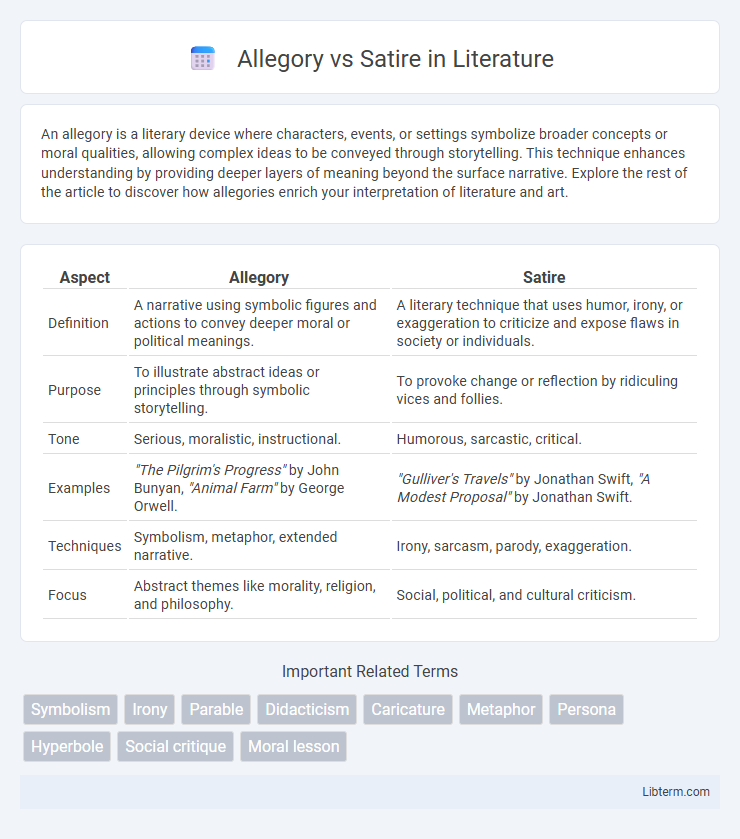An allegory is a literary device where characters, events, or settings symbolize broader concepts or moral qualities, allowing complex ideas to be conveyed through storytelling. This technique enhances understanding by providing deeper layers of meaning beyond the surface narrative. Explore the rest of the article to discover how allegories enrich your interpretation of literature and art.
Table of Comparison
| Aspect | Allegory | Satire |
|---|---|---|
| Definition | A narrative using symbolic figures and actions to convey deeper moral or political meanings. | A literary technique that uses humor, irony, or exaggeration to criticize and expose flaws in society or individuals. |
| Purpose | To illustrate abstract ideas or principles through symbolic storytelling. | To provoke change or reflection by ridiculing vices and follies. |
| Tone | Serious, moralistic, instructional. | Humorous, sarcastic, critical. |
| Examples | "The Pilgrim's Progress" by John Bunyan, "Animal Farm" by George Orwell. | "Gulliver's Travels" by Jonathan Swift, "A Modest Proposal" by Jonathan Swift. |
| Techniques | Symbolism, metaphor, extended narrative. | Irony, sarcasm, parody, exaggeration. |
| Focus | Abstract themes like morality, religion, and philosophy. | Social, political, and cultural criticism. |
Defining Allegory: Meaning and Key Features
Allegory is a literary device where characters, events, or settings symbolize deeper moral, spiritual, or political meanings beyond the literal narrative. Key features include a dual-layered story with a surface-level plot and an underlying symbolic significance, often conveying complex ideas through metaphorical representation. Unlike satire, which primarily aims to criticize or mock, allegory strives to illustrate universal truths or ethical lessons through extended symbolism.
Understanding Satire: Purpose and Techniques
Satire employs humor, irony, and exaggeration to criticize or expose societal flaws, aiming to provoke change or reflection. It targets specific issues or figures, using techniques like parody, sarcasm, and understatement to highlight absurdities and prompt critical thinking. Unlike allegory's extended symbolic narrative, satire's direct, often biting approach engages audiences through wit and sharp commentary.
Fundamental Differences Between Allegory and Satire
Allegory represents ideas and principles through symbolic characters, events, and narratives to convey a hidden meaning, often moral or political. Satire uses humor, irony, and exaggeration to criticize or mock social issues, individuals, or institutions, aiming to provoke change or awareness. The fundamental difference lies in allegory's emphasis on symbolic storytelling for deeper interpretation, whereas satire focuses on wit and ridicule to expose flaws.
Historical Evolution of Allegory in Literature
Allegory has evolved from ancient texts such as Plato's "Allegory of the Cave" to medieval morality plays and Renaissance works like Edmund Spenser's "The Faerie Queene," embodying complex moral and spiritual ideas through symbolic narratives. In literature, allegory developed as a method to convey multi-layered meanings, often reflecting societal and religious contexts across different historical periods. This evolution contrasts with satire's focus on social criticism and irony, emphasizing allegory's enduring role in exploring abstract concepts through metaphorical storytelling.
The Role of Satire Across Cultures and Eras
Satire serves as a powerful tool for social criticism, adapting across cultures and historical periods to challenge authority and expose societal flaws through humor and irony. Unlike allegory, which conveys abstract ideas through extended metaphorical narratives, satire directly engages with contemporary issues, often provoking reflection and reform. From Ancient Greek comedies to modern political cartoons, satire's enduring role highlights cultural values and tensions, making it a dynamic and transformative literary device worldwide.
Famous Examples of Allegory in Classic and Modern Works
Famous examples of allegory in classical literature include George Orwell's "Animal Farm," which uses farm animals to symbolize the Russian Revolution and critique totalitarian regimes, and John Bunyan's "The Pilgrim's Progress," depicting a Christian's journey to salvation. In modern works, "The Matrix" film series presents a complex allegory on reality and control, while Suzanne Collins' "The Hunger Games" serves as an allegory for socio-political oppression and the struggle for freedom. These works utilize allegory to convey deeper moral, political, or philosophical meanings through symbolic characters and narratives.
Notable Works That Exemplify Satire
Jonathan Swift's "Gulliver's Travels" masterfully employs satire to critique human nature and social institutions through fantastical voyages. George Orwell's "Animal Farm" is a prominent satirical allegory exposing the corruption of revolutionary ideals in Soviet communism. Mark Twain's "The Adventures of Huckleberry Finn" uses satire to challenge entrenched racial prejudices and societal norms in 19th-century America.
The Interplay: When Allegory Meets Satire
The interplay of allegory and satire creates a powerful narrative device where allegory provides a symbolic framework and satire delivers sharp social critique. Satirical allegories use metaphorical characters and scenarios to expose flaws in politics, culture, or human behavior with wit and irony. This fusion enhances the impact, making complex messages more accessible and thought-provoking for diverse audiences.
How to Identify Allegory vs. Satire in Texts
To identify allegory in texts, look for a narrative where characters, events, or settings symbolize broader abstract ideas or moral qualities, often conveying complex political, spiritual, or social meanings. Satire, on the other hand, employs humor, irony, or exaggeration to criticize or ridicule specific individuals, institutions, or societal norms, with a clear intent to provoke change or highlight folly. Analyzing tone and purpose helps distinguish allegory's symbolic storytelling from satire's pointed, often biting commentary.
The Impact of Allegory and Satire on Society
Allegory and satire shape societal values by using symbolic narratives and humor to critique political and cultural issues, influencing public perception and encouraging critical thinking. Allegories, such as George Orwell's "Animal Farm," provide layered meanings that provoke reflection on power and morality, while satire exposes hypocrisy through irony and exaggeration, promoting social awareness. Both forms drive social change by challenging dominant ideologies and inspiring dialogue on ethical and political reforms.
Allegory Infographic

 libterm.com
libterm.com